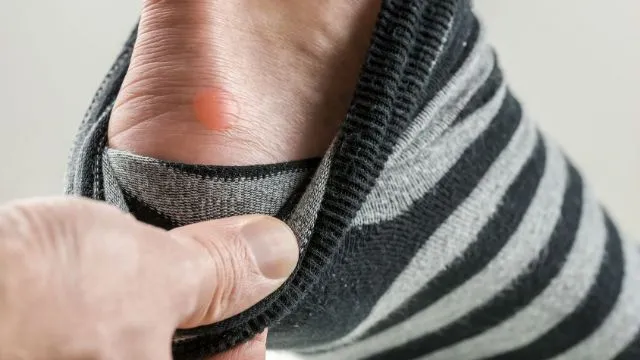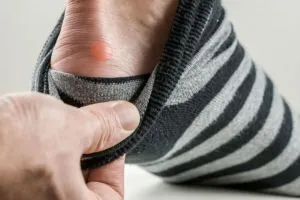
- Share on Facebook43
- Share on Pinterest
- Share on Twitter
Blisters on your feet can be caused by a number of different factors, such as wearing shoes that are too tight or too loose, but they all start the same way: friction. Friction causes the layers of skin to separate, and foot blisters are those painful pockets of air or fluid that form between the layers.
If you do a lot of walking, rubbing and friction are pretty much inevitable, even if you’re wearing the best-fitting shoes. They often result when the feet perspire and socks stick to your skin as the friction from walking pulls the skin back and forth over underlying tissue.
Of course, preventing blisters from ever occurring in the first place is the best course of action. To decrease the chances of developing one or more, take the following actions.
Shoe fit. The number one thing to do to prevent blisters is to make sure your shoes fit properly. When trying on new shoes, remember that everyone’s feet tend to swell as the day moves on as well as during physical activities.
Keep in mind that it’s also important to be sure they fit both feet, as one foot may be larger than the other. If you’re still wearing an older pair of shoes that just aren’t comfortable, it’s probably time to donate or toss them.
The right socks. Even if your shoes fit well, when feet perspire, your socks can move around inside your shoes, causing friction. Rather than wearing cotton socks that tend to hold sweat and frequently bunch up, choose socks that are made from a synthetic blend that wicks away moisture, like CoolMax. To reduce moisture, powder your feet and socks before you put your shoes on.
Lubricant. Before activities like walking, running or hiking, apply a lubricant such as Bodyglide to areas that are blister prone. Unfortunately, petroleum jelly or Vaseline isn’t very effective as it tends to melt and thin out.
To heal a blister, it’s important to address the problem at its very first signs, but don’t pop it unless it’s filled with a lot of fluid and is so painful that you have difficulty walking even in your most comfortable shoes.
If necessary, pierce the blister with a needle that’s been cleansed and sterilized. Be sure your hands and fingers are clean, and then sterilize the needle by placing it into a flame until it glows red and then allowing it to cool.
Or, you can wash the needle with soapy water and then rub it down with alcohol. Only pierce the dead skin, which is the top of the blister, and leave the remaining loose skin which helps it to heal faster.
Afterwards, apply tea tree oil and cover with moleskin or gauze. Moleskin is a softer, more breathable bandage alternative. Change the bandage daily until the blister has completely healed.
 To protect and heal a developing blister, apply moleskin at the first signs of redness. Soaking it in apple cider vinegar can also help it heal more quickly and prevent infection as it contains natural antibacterial properties.
To protect and heal a developing blister, apply moleskin at the first signs of redness. Soaking it in apple cider vinegar can also help it heal more quickly and prevent infection as it contains natural antibacterial properties.
Taking care of your feet is important for staying active and healthy!
-The Alternative Daily
- Share on Facebook43
- Share on Pinterest
- Share on Twitter

